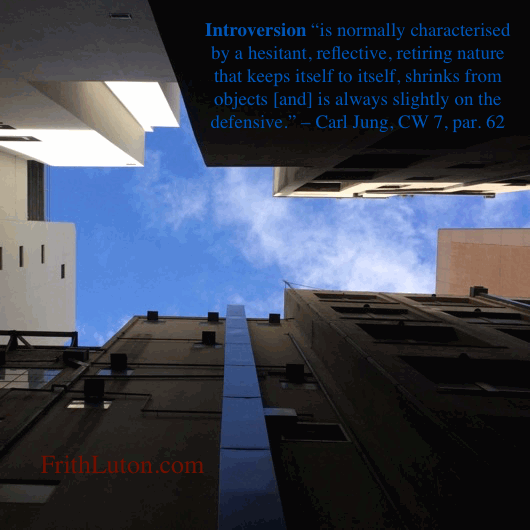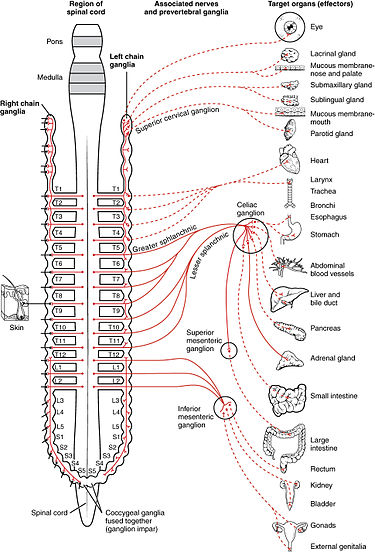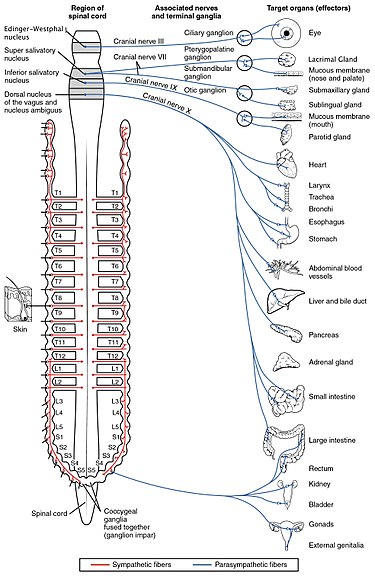and consider these rules are wiring related; the brain has a capacity to modify its wiring so is more like a telephone exchange than a computer. Therefore the hardware constraints are likely the reason these rules limit the ways the functions can work together.
How right you are.
We have a sympathetic nervous system and a parasympathetic nervous system. The sympathetic nervous system reacts very quickly to changes in the environment, and has been used as the explanation for the fight/flight/freeze instinct.
The parasympathetic nervous system mulls over things for a very long time before coming to answers.
They have been compared to the behaviour of extroverts and introverts, as if the sympathetic nervous system accounts for extroversion, and the parasympathetic nervous system accounts for introversion.
But the extent of this didn't really hit me until I saw diagrams like these.
They are from the wiki article on the
Autonomic nervous system. They're not the exact diagrams that I saw. But they give you an idea:
Here's a diagram of the symathetic nervous system:
Now here's a diagram of the parasympathetic nervous system:
We actually have TWO sets of nerve connections on the spinal cord!
TWO SETS OF NERVES!
Think of the nerves as sending information down wires like in a telephone exchange, exactly as you described.
Well, we have 2 parallel sets of wires in that exchange, like 2 telephone exchanges that connect to the same phones. But they exist in parallel to each other.
As a result, if you're sending/receiving signals along the extraverted SNS, the intraverted PNS is free to also send/receive other signals.
So you can send/receive an extraverted function, and send/receive an intraverted function, simultaneously.
But obviously, if you try to send 2 different types of data along the same wires simultaneously, the signals could get mixed up. You could get severe signal corruption.
So probably, if you're using Ne, you can't also use Se at the same time, because you'd be using the same circuit for 2 different functions.
But you could use Ne and Si now, and then Se and Ni at another time.
There's probably a similar connection between judging functions.
Probably, you could use Ne and Te at the same time, as one is a perceiving function and the other is a judging function and so the signal types are different. But I'd imagine that would be difficult.
Also, using Ne & Si simultaneously, would be very difficult, as they're both sending the same types of data. So you'd be receiving similar types of data into the brain in general.
It would probably be much easier to use one circuit for perceiving and the other for judging, such as using Ne and Ti simultaneously, or Ne and Fi.
But obviously, you'd probably end up getting better at one set, than the other, like how people have a favourite hand. So most of the time, you'd use Ne & Si. But occasionally you could use Se & Ni. However, you probably wouldn't be nearly as skillful or as fast with Se & Ni, because it's not something that you're used to, much as you can probably write with your other hand, but either fast and unintelligibly, or slowly but not that great.
Over time, you'd probably get used to using one extravertd function and one intraverted function, simultaneously, very, very fast, one of which would be a perceiving function and one a judging function.
So you'd probably develop one extraverted function, and one intraverted function, one of which would be a perceiving function and one a judging function, as your regular way of thinking.
The other patterns would develop as well, but less so.
I'm guessing, that you'd also develop use of one perceiving function more (N/S), one judging function more (T/F), and one nervous system more (E/I).
There's also the
enteric nervous system, which deals with the gastro-intestinal tract, and is said to act as a second brain. But to send/receive messages elsewhere via the spinal cord, it still relies on the SNS and the PNS. It might explain how some people are an X. But I just saw the ENS. So I need to think on that one.
Well, that's my idea, based on those diagrams. I think it explains a lot.



